
Patty Wagstaff is an American aviator and U.S. national aerobatic champion.
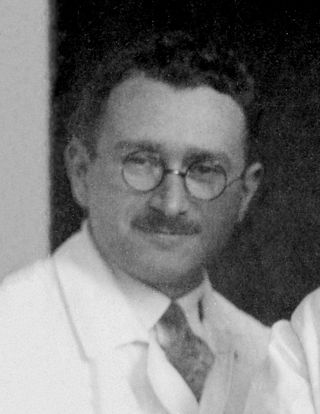
Sir Ludwig Guttmann was a German-British neurologist who established the Stoke Mandeville Games, the sporting event for people with disabilities (PWD) that evolved in England into the Paralympic Games. A Jewish doctor who fled Nazi Germany just before the start of the Second World War, Guttmann was a founding father of organized physical activities for people with disabilities.

A spinal cord injury (SCI) is damage to the spinal cord that causes temporary or permanent changes in its function. Symptoms may include loss of muscle function, sensation, or autonomic function in the parts of the body served by the spinal cord below the level of the injury. Injury can occur at any level of the spinal cord and can be complete, with a total loss of sensation and muscle function at lower sacral segments, or incomplete, meaning some nervous signals are able to travel past the injured area of the cord up to the Sacral S4-5 spinal cord segments. Depending on the location and severity of damage, the symptoms vary, from numbness to paralysis, including bowel or bladder incontinence. Long term outcomes also range widely, from full recovery to permanent tetraplegia or paraplegia. Complications can include muscle atrophy, loss of voluntary motor control, spasticity, pressure sores, infections, and breathing problems.
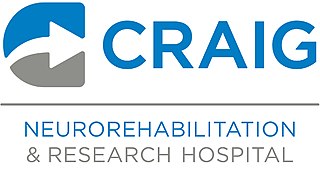
Craig Hospital is a neurorehabilitation and research hospital in Englewood, Colorado specializing in spinal cord injury (SCI) and traumatic brain injury (TBI) rehabilitation and research. Craig is a 93-bed, private, not-for-profit, free-standing long-term acute care and rehabilitation hospital that provides a comprehensive system of inpatient and outpatient medical care, rehabilitation, neurosurgical rehabilitative care, and long-term follow-up services. Half of Craig's patients come from outside of Colorado each year, and in the past four years Craig has treated patients from all 50 states and several foreign countries. At any given time, the staff at Craig treats approximately 55 inpatients with spinal cord injuries, 30 with traumatic brain injuries, and 50-60 outpatients. Craig provides housing for out-of-state families and outpatients, including the first 30 days free for families of new inpatients.

The Summer Paralympics also known as the Games of the Paralympiad, are an international multi-sport event where athletes with physical disabilities compete. This includes athletes with mobility disabilities, amputations, blindness, and cerebral palsy. The Paralympic Games are held every four years, organized by the International Paralympic Committee. Medals are awarded in each event, with gold medals for first place, silver for second and bronze for third, a tradition that the Olympic Games started in 1904.
Clayton Gerein was a Canadian wheelchair athlete, who won 14 medals in racing events at the Paralympic Games between 1984 and 2008.
T51 is disability sport classification for athletics. The class includes people with a number of different types of disabilities including spinal cord injuries and cerebral palsy. Similar classifications are T52, T53, T54 and T55. It is for sportspeople with minimal upper body function who use a wheelchair, spinal cord injury class F1 and Les Autres class LAF1.

Eileen Mary Perrottet was an Australian physiotherapist, noted for her contributions to the Australian Paralympic Movement, a senior physiotherapist at Mount Wilga Rehabilitation Hospital in the Sydney suburb of Hornsby.
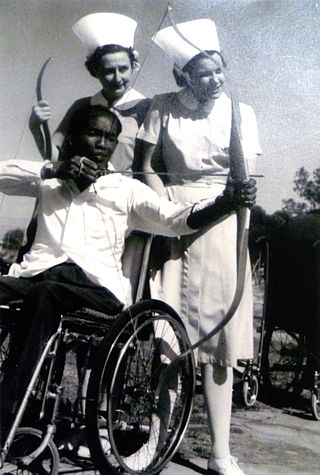
Janet Tyler OAM is an Australian Registered Nurse who was a member of the medical team selected to care for Australian athletes at the 1968 Summer Paralympics, Israel. She specialised in spinal nursing and rehabilitation at the Royal Adelaide Hospital and the Hampstead Rehabilitation Centre annex of Royal Adelaide Hospital, throughout the forty three years of her nursing career. Tyler was Senior Registered Nurse from 1964-1977, Clinical Nurse Coordinator from 1977-1986, Acting Nurse Manager at the Hampstead Centre from 1986-1994, Life Member of the Registered Nurse Association since 1951, Life Member of the Paraplegic and Quadriplegic Association of South Australia since 1977 and Justice of the Peace for over 30 years.
LC1 is a para-cycling classification. It includes a number of types of people with disabilities including people with amputation and spinal cord injuries that are mostly confined to the upper limbs. This class includes people from the ISOD A5 class, A6 class, A7 class and A8 class.
Para-alpine skiing classification is the classification system for para-alpine skiing designed to ensure fair competition between alpine skiers with different types of disabilities. The classifications are grouped into three general disability types: standing, blind and sitting. Classification governance is handled by International Paralympic Committee Alpine Skiing. Prior to that, several sport governing bodies dealt with classification including the International Sports Organization for the Disabled (ISOD), International Stoke Mandeville Games Federation (ISMWSF), International Blind Sports Federation (IBSA) and Cerebral Palsy International Sports and Recreation Association (CP-ISRA). Some classification systems are governed by bodies other than International Paralympic Committee Alpine Skiing, such as the Special Olympics. The sport is open to all competitors with a visual or physical disability. It is not open to people with intellectual disabilities.

Para-Nordic skiing classification is the classification system for para-Nordic skiing which includes the biathlon and cross-country events. The classifications for Para-Nordic skiing mirrors the classifications for Para-Alpine skiing with some exceptions. A functional mobility and medical classification is in use, with skiers being divided into three groups: standing skiers, sit skiers and visually impaired skiers. International classification is governed by International Paralympic Committee, Nordic Skiing (IPC-NS). Other classification is handled by national bodies. Before the IPC-NS took over classification, a number of organizations handled classification based on the type of disability.
Paralympic powerlifting classification is the system designed for disability based powerlifting to insure that there is level competition across a range of disabilities. Categories are broken down based on weight. The sport's classification is governed by International Paralympic Committee Powerlifting. People with physical disabilities are eligible to compete in this sport.
LTA-PD is an adaptive rowing classification for people with physical disabilities that was developed in March 2011. It includes people with spinal cord injuries generally at around the S1 level. It also includes people with cerebral palsy. People in this class have issues with their legs, arms and trunk.
Alastair Smales was born on 8 May 1962, in Australia. He lost the use of his legs in 1992 becoming a paraplegic after a four-wheel drive he was fixing slipped off a jack and fell on him. Due to this injury, Smales is now classified a S6 wheelchair grade in swimming competitions.

Maria Leonidovna Komissarova is a Russian athlete who competes in freestyle skiing. She was due to compete at the 2014 Winter Olympics, but during a training run before her event, she fractured a vertebra with a dislocation of her spine, rendering her unable to compete.

Monique Murphy is an Australian Paralympic swimmer. She represented Australia at the 2016 Rio Paralympics where she won a silver medal.
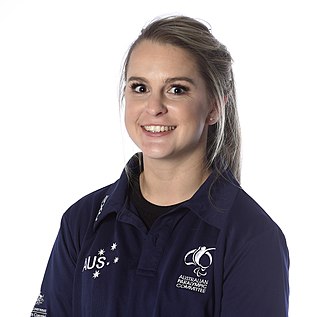
Emma Booth is an Australian Paralympic equestrian. She represented Australia at the 2016 Rio Paralympics and the 2020 Tokyo Paralympics.
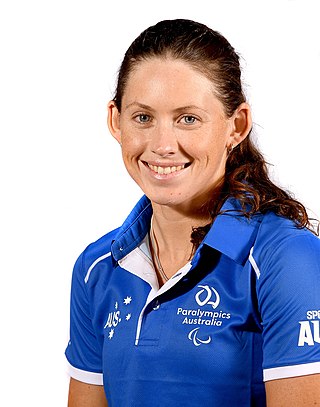
Lauren Parker is an Australian paratriathlete. She won a silver medal at the 2020 Summer Paralympics.
Clara Brown is an American para cyclist who competes in international level events in both track cycling and road cycling.












